
This year, the US dollar index has been down by more than 13%.
The greenback continues to suffer losses as investors are betting that the Fed will maintain a super-soft monetary policy and a new round of economic relief and stimulus will help the national economy recover in 2021.
The fact that investors expect the US dollar to continue losing ground supports the stock markets.
Since the beginning of the year, the S&P 500 has been up by 15%, despite the economic hardships caused by the coronavirus spread in the United States.
For every 10 percent drop in the dollar, S&P 500 profits on a per share basis increase by 3 percent, according to Bank of America.
Stocks opened the previous trading day with gains amid reports that US President Donald Trump could veto a bipartisan economic rescue bill. However, this news took a back seat as investors decided that Congress could easily bypass Trump's veto.
In addition, stocks were supported by the statements of medical experts that the already developed vaccine against COVID-19 should be effective against a new coronavirus strain.
As a result, the S&P 500 index rose by 0.1% to 3,690.01 points on Wednesday.
Apparently, the market is currently mulling over the recent rally and is waiting for another driver for growth shortly before the new year.
"The fact that equity indices traded mostly in the green this morning reflects a consensus expectation that Trump will sign the budget into law, although he could wait until the eleventh hour," a strategist at Rabobank said in a statement.

On Wednesday, the US currency extended weakness against its main competitors amid disappointing statistics from the United States. Although initial unemployment claims in the country did not grow as much as expected, it still exceeds the 800 thousand mark. In November, US orders for durable goods slowed down, household income and expenses decreased, and new home sales fell sharply.
The day before, the US dollar index sank by 0.3%. On Thursday, it was down by more than 0.2% to 90.1.
The main currency pair has advanced for the second consecutive trading session. However, it is obvious that it does not have enough momentum to go beyond the range formed in early December.
The pre-holiday mood and thin market keep traders from aggressive bets.
The euro/dollar pair has been able to defend the weekly trend support level, which is currently taking place in the area of 1.2170. In case the price breaks through it and consolidates below it, this will be the first sign of fading bullish momentum. If the price dips below 1.2100, a bearish breakout will be confirmed and the pair will go towards the psychologically important level of 1.2000 at an accelerated pace.
Meanwhile, if the price is able to rise above 1.2270-1.2175 (annual highs), the pair will move towards the levels of 1.2300 and 1.2340. In this case, the price is likely to face the round mark of 1.2400 (for the first time since April 2018).
The safe-haven greenback continues to trade under pressure amid hopes for a UK-EU trade deal.
The final Brexit deadline is rapidly approaching. However, the very fact that talks between London and Brussels still continue on Christmas Eve signals the parties' willingness to do everything to prevent an exit without a deal.
If the parties finally reach a compromise on this crucial issue, we may see a rally not only in the pound but also in many other risky currencies.
In this scenario, the pound/dollar pair may jump to 1.4000. If the negotiations fail, it risks falling by 3-5%.





















